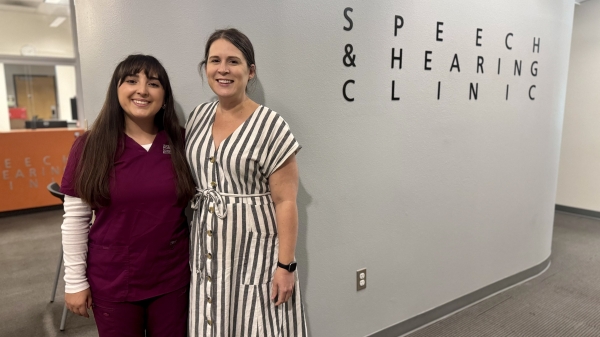Arizona public health leader to direct Health Observatory at ASU

David Engelthaler, executive director of the Health Observatory at Arizona State University. Image by Andy Keena
Think about any health scare in recent Arizona history — from hantavirus and plague to anthrax and COVID-19 — and you can be sure David Engelthaler was working behind the scenes to help the state navigate through the emergency.
Engelthaler brings his passion for public health to his new role as executive director of the Health Observatory at Arizona State University, a new research initiative at ASU Health that looks at the health of Arizonans to prepare the state to identify, track and mitigate future crises.
“I think one of the most important and underutilized natural resources that we have in Arizona is innovation. There’s no better place to think about innovation than ASU, the most innovative school in the country," Engelthaler said. "It doesn’t happen by accident. It happens because you have a lot of really smart people, really creative people and people with vision.”
The Health Observatory at ASU aims to provide a comprehensive, data-driven understanding of community health to create a more equitable, resilient, impactful and cost-effective health care system. It will also drive medical innovation to better detect, respond to and prevent emerging threats.
Engelthaler brings 30 years of experience protecting public health across Arizona to his new role as its director.
Helping solve a health mystery
During the spring of 1993, a mysterious respiratory disease struck the Four Corners region, including the Navajo Nation. Young and healthy people suddenly became ill with flu-like symptoms and often died of pulmonary edema, normally caused by heart disease.
“Nobody knew what it was, and it took a couple of months to figure out it was a new virus called hantavirus showing up in wild rodents. In the public health world, no one even thought of this virus as occurring in the Western Hemisphere,” Engelthaler says. “We had no idea who was at risk and how they were getting exposed to it.”
When news hit about the deadly hantavirus, Engelthaler was working as a biologist for the U.S. Forest Service.
“The job was great, but it didn’t feel as fulfilling as I expected. I saw a job application for a hantavirus epidemiologist tasked with gaining a greater understanding of hantavirus in its natural environment and doing field testing and habitat assessments. I jumped in, and I’ve been completely addicted to public health ever since. I’m fascinated by using science to improve our understanding of the natural world while improving people’s health and lives. For the next 30 years, it’s where I dedicated my life.”
Later, as he was investigating a plague outbreak in the Painted Desert in the northeast corner of Arizona, he connected with the Centers for Disease Control and Prevention’s national leadership. The connections led to a fellowship and full-time job as a biologist with the CDC in its Fort Collins, Colorado, office, where he gained a deep understanding of genomics and how to apply it in the battle against infectious disease.
“The role brought me in touch with dangerous pathogens, such as plague, anthrax, tularemia and other bad things that occur naturally and have been used as biological weapons. I worked to really understand these organisms in their natural environment and what happened if they were used inappropriately,” he says.
Arming Arizona against biological warfare
Engelthaler’s expertise paved the way for a new role as the biodefense coordinator responsible for examining the biological weapons threat for the state of Arizona in 2000.
“My role was essentially thinking about what happens if terrorists or someone else used biological weapons. Do we have the emergency structures in place? Does public health know how to work in that framework? At the time, the state really didn’t have capabilities during a public health emergency. It was a bigger task than just understanding dangerous germs. It was understanding how to connect the public health department with the FBI and local fire and police departments, as well as build up the public health infrastructure needed to respond to large-scale emergencies, pandemics or even a biological weapons attack,” he says.
Within two years of Engelthaler becoming the state’s biodefense coordinator, the threat of a biological weapons attack became a terrifying reality. Soon after the terrorist attacks of 9/11, letters laced with anthrax began appearing in the mail across the country. Five Americans were killed and 17 were sickened in what became the worst biological attacks in U.S. history.
“I had to become an emergency response official. I worked 24/7 for months during a time everybody thought every powder was suspicious,” he says. “I learned how to build collaborations across agencies from national to state to local tribes and in different fields, from public safety and public health to veterinary medicine and agriculture. We essentially created the public health emergency response infrastructure, including developing things like incident command systems for public health, building out a cutting-edge public health lab and developing detailed protocols for how to respond to things like suspicious powders or other biological threats to Arizona.
“Perhaps one of the most important things I learned over the years is how do you bring leadership to really affect change or lead through a critical moment."
Expanding impact in public health
Engelthaler brought those leadership skills to his roles as the state epidemiologist for the Arizona Department of Health Services and later as the director of TGen North, the northern Arizona division of the nonprofit Translational Genomics Research Institute. He also served as the scientific director of the TGen North Clinical Laboratory, which was started in March 2020 to provide COVID-19 testing. The lab provided tests for tens of thousands of underserved Arizonans, especially in tribal and rural communities.
Looking back, it seems all the twists and turns of his accomplished career led him to his new role at the helm of the Health Observatory at ASU.
“David Engelthaler’s experience with major health crises, including COVID-19, and his commitment to public health make him a key asset to ASU’s Health Observatory,” says Sally C. Morton, executive vice president of ASU Knowledge Enterprise. “His role will be crucial in advancing our initiative to integrate statewide data and provide early warnings for informed decision-making for state leaders.”
The Health Observatory’s approach will leverage real-time and holistic data to provide leaders with the information they need to take action quickly. It’s a model that will improve health outcomes for Arizona and one that can scale nationally to help leaders across the country make more informed public health decisions.
Engelthaler says he’s brimming with excitement.
“For possibly the first time ever, we’re going to draw on traditional and nontraditional data sources to find ways to generate new informative data using genomics and other tools such as artificial intelligence to do advanced analysis. We’ll be able to gather all these different and disparate data sources, interpret them and make them useful for people in everyday life, whether it’s the general public, policymakers or health care and public health leaders,” he says. “It will be a real asset for the health of all Arizonans.”
More Health and medicine
College of Health Solutions alum poised to make global health impact
At the intersection of health care and technology lies the potential for both great benefit and great harm. In 2021, when a COVID-19 vaccination-tracking app was hacked and the personal health…

College of Health Solutions program helps Parkinson’s patients ‘speak out’
Degenerative diseases are of an especially insidious nature in that they only get worse over time. One such disease, Parkinson’s, is known for a common manifestation called hypokinetic dysarthria, or…

ASU researchers are using AI to improve health outcomes for women
Cardiovascular disease affects more women than all forms of cancer combined. It is the leading cause of death, killing one in three women annually. It is also responsible for more than 30% of…